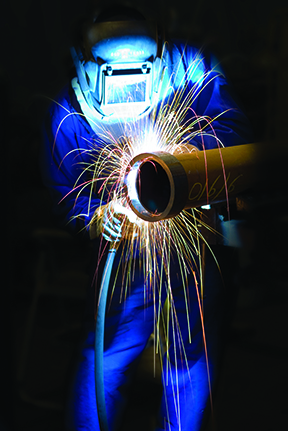Tips for Achieving Success When Welding High-Strength Low-Alloy Steels
In today’s competitive marketplace, it’s more important than ever for companies to find ways to boost productivity and maintain high levels of quality. In some applications, making changes in the welding operation can yield these advantages, along with generating a positive impact on the bottom line. Changing materials, in particular, can be helpful. High-strength low-alloy (HSLA) steels are one option.

In addition, HSLA steels are a good option when the application requires high strength in challenging environmental conditions or when other specific mechanical properties are needed.The properties of HSLA steels allow for materials that are thinner and more lightweight — without sacrificing strength or toughness. As a result, HSLA steels can help companies reduce the weight, and therefore costs, for material transport; this is especially advantageous in the case of contractors moving pipe to a job location. The ability of HSLA steels to be thinner than traditional carbon steels, while providing the same strength, also allows welding operators to complete welds faster since fewer passes are necessary — which, in turn, increases productivity.
Successfully welding HSLA steels requires attention to several factors, including heat input, interpass temperatures and surface cleaning. It’s also important to consider filler metal selection.
The basics of HSLA steels
Because of its higher strength-to-weight ratio and specific mechanical properties, HSLA steels are well-suited for applications where the material must withstand lower temperature environments, as well as those that require higher abrasion and corrosion resistance.
HSLA steels are typically low in carbon and contain alloying elements such as nickel, chromium, molybdenum, niobium and vanadium, which increase strength and toughness for better impact resistance. Another common alloying element in this material is titanium, which bonds with and pulls out the nitrogen from the material, helping to limit grain size. The smaller grain structure is what allows for increased toughness, while still maintaining the high strength of the material. Typical tensile strength for HSLA steel is above 80,000 psi, but can range from 60,000 to over 120,000 psi.
The material is becoming more commonly used in many industrial applications, including transmission pipelines (ranging from X52 to X100 pipe), heavy equipment, shipbuilding, railcars and structural steel.
Overall, weldability of these materials is quite good. However, there are some factors to keep in mind when welding HSLA steels.
Best practices for welding HSLA steels
There are several best practices that are key to achieving success when welding HSLA steels. These include cleaning the material surface, proper preheating and maintaining necessary interpass temperatures.
- Ensure a clean surface: It is essential to clean prior to welding and in-between weld passes. Proper pre-cleaning helps keep hydrogen from entering the weld, which can lead to cracking and other issues. Use a belt sander, flap disc, grinding wheel or wire wheel to remove any oxidation, oils or other surface contaminants from the base material before welding critical joints.
- Proper preheating: The main purpose of preheat is to control and slow the rate of cooling of the weld, which allows more diffusible hydrogen to dissipate from the completed weld, minimizing the risk of hydrogen cracking. Preheating also minimizes shrinkage stress and helps maintain more favorable microstructures that increase toughness. Proper preheating temperatures depend on the specific type and thickness of HSLA steel being used. Complete a carbon equivalency formula or consult the applicable welding code to help determine the correct temperature for the application. Also, be sure to preheat enough of the area around the weld joint, rather than just the weld joint itself, to account for quenching of the material and help ensure it is heated throughout.
- Maintain interpass temperatures: Just as it’s crucial to properly preheat the material, monitoring and maintaining the necessary interpass temperature is also very important when welding HSLA steels. Putting too much heat into the material during welding can alter the grain structure — making grains larger, increasing the size of the heat-affected zone (HAZ) and changing the microstructure of the weld. These changes can reduce impact strength and increase ductility of the finished weld. The larger the grains, the greater the tendency toward crack propagation due to the building of dislocations at the grain boundaries. Again, proper interpass temperatures will depend on the specific type and thickness of HSLA steel being welded — and be determined by consulting the applicable welding code. Filler metal manufacturers can help navigate code details or provide suggestions if there are no code requirements available. Monitoring interpass temperatures of the material can be done with numerous types of heat-sensing devices, including temperature-indicating crayons or contact pyrometers.
Filler metal options
Another important consideration that can impact productivity, efficiency and quality in welding HSLA steels is filler metal selection. The filler metals used for the applications must provide similar characteristics as the material itself, including strength and/or corrosion resistance.

Selecting a product for a particular application is typically driven by a code or specification, but there can still be some confusion when it comes to filler metal selection. Depending upon what the code book states, a specific American Welding Society (AWS) class of filler metal may be shown, while other times it may not be as clear. In these situations, try to either match the chemistry of the base material to the filler metal or match the mechanical properties. It is typically best to attempt to match both as much as possible.Self-shielded and gas-shielded flux-cored wires found in AWS specification A5.29, Specification for Low-Alloy Steel Electrodes for Flux Cored Arc Welding, are often a good choice for HSLA steel applications. In general, it’s recommended to select a low-hydrogen filler metal when possible to help control hydrogen in the weld.
Another item to look at when selecting a low-alloy tubular filler metal is the deposit composition designator. Table 7 in A5.29 gives a detailed description of the weld metal chemical composition requirements for each designator. Typical results for a specific wire can usually be found on the filler metal manufacturer’s website, as well. The following are some self-shielded flux-cored wire examples: An EXXTX-K6 wire, which uses less than 1 percent nickel and provides a range of 60 to 70 ksi tensile strength, along with excellent toughness. Note, a K6 wire is actually on the low end of the spectrum of HSLA. Other wires such as those classified as EXXTX-Ni1 and Ni2 use up to 1.1 to 2.75 percent nickel to achieve high impact strength at low temperatures. All three of these wires are very common for pipeline and offshore applications.
Within the self-shielded flux-cored wire market, one of the most common usability designator for welding HSLA is EXXT8. T8 wires have good weldability, are all-position wires and can be used for multi-pass welding. These characteristics make them good for pipeline welding, among other applications. These wires also provide good impact toughness. Typically, T8 wires for transmission pipe are designed for welding downhill (vertical down on pipe), while others designed for offshore applications are meant to be welded uphill (vertical up on pipe). Some of these wires are designed to operate in both directions for a better appearance — for instance, on uphill fill passes and downhill cap passes.
For gas-shielded wires, options are EXXT1-XC/EXXT1-XM and EXXT5-XC/EXXT5-XM. Generally, T1 wires will have better weldability than the T5 options. This is because the highly basic slag system of T5 wires is not designed for great weldability. It has a low melting point and creates a puddle that is more fluid and challenging to control unless in the flat position, although it does offer increased toughness for high strength applications.
New advancements and designs available in some T5 classified wires, however, have improved weldability greatly — even out of position. These newer T5 gas-shielded products operate on DC current, negative polarity (DCEN), meaning they operate similar to self-shielded wires. The E121T5-GC H4 gas-shielded wire, in particular, is a good option for applications needing high strength with increased toughness for critical welds at low temperatures, including shipbuilding, bridges, storage vessels and earthmoving equipment.
With both self-shielded and gas-shielded wires, the strength designators vary. Typically, self-shielded options have 70, 80 and 90 ksi tensile strength, while some gas-shielded wires offer up to 120 ksi.
Achieving success
High-strength low-alloy steels offer numerous benefits that make them well-suited to meet the demanding requirements of many welding applications. Because they are lightweight and thinner than other materials — without compromising strength or toughness — they allow welding operations to save money in transportation costs and improve welding productivity, while still meeting code and quality requirements.
Following some key best practices when welding HSLA steel, and choosing the proper filler metals for the specific application, are steps that can help in achieving success with the materials.



